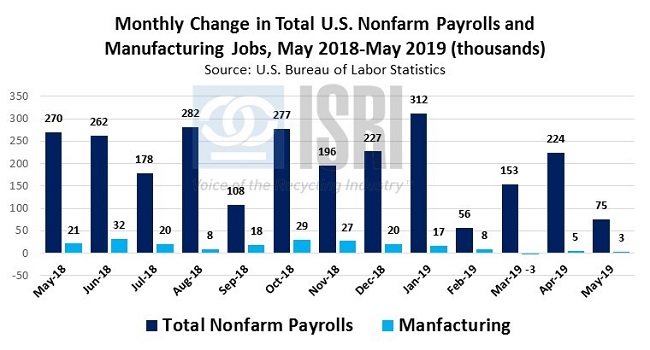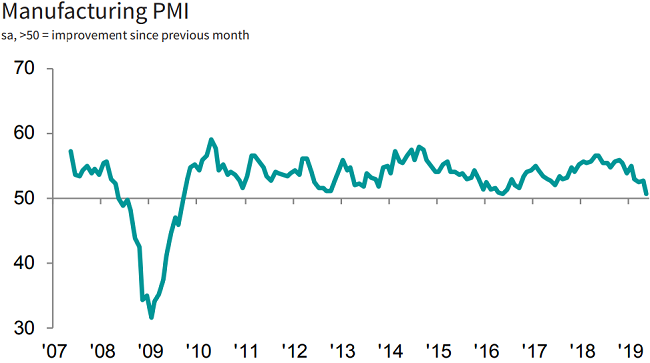Amid the uncertainty on the trade front and lackluster economic reports, Fed officials signaled more flexibility on monetary policy last week, which in turn gave a boost to equity markets. Federal Reserve Bank of New York President John Williams said that Fed officials “need to be prepared to adjust our views of what’s happening in the economy and where the economy’s likely to go” while also considering “the right policy to keep this economy on a good, strong growth path,” the WSJ reports.
The Dow Industrials finished 263.28 points higher on Friday, a gain of more than one percent. Stock futures were pointing higher over the weekend following the announced immigration deal with Mexico. The Financial Times reports “The US and Mexico have reached a deal to curb migration, defusing Donald Trump’s threat to impose sweeping tariffs on Mexican imports after several days of tense negotiating sessions in Washington… The deal caps an eight-day saga that began when Mr. Trump abruptly announced he was moving to slap tariffs on all Mexican goods from June 10... In addition to the trade war with China, the threat of higher tariffs on goods from Mexico, whose economy is deeply integrated with the US, had caused further unease in financial markets, contributed to fears about a US economic slowdown, and accelerated talk that the Federal Reserve might be forced to cut interest rates as its next move.”
A weaker than expected jobs report out last week also contributed to concerns about a U.S. economic slowdown. According to the Bureau of Labor Statistics, total U.S. nonfarm payrolls expanded by just 75,000 in May against the consensus forecast for a gain of 180,000 jobs. Meanwhile, hiring in the manufacturing sector has slowed considerably in recent months:

Other U.S. manufacturing indicators have underwhelmed recently. According to the Institute for Supply Management, the U.S. manufacturing PMI declined from 52.8 in April to 52.1 in May. The manufacturing PMI report from IHS Markit showed an even bigger drop, declining to 50.5 last month.

Source: IHS Markit
Here’s what Chris Williamson, Chief Business Economist at IHS Markit, had to say: "May saw US manufacturers endure the toughest month in nearly ten years, with the headline PMI down to its lowest since the height of the global financial crisis. New orders are falling at a rate not seen since 2009, causing increasing numbers of firms to cut production and employment. At current levels, the survey is consistent with the official measure of manufacturing output falling at an increased rate in the second quarter, meaning production is set to act as a further drag on GDP, with factory payroll numbers likewise in decline.” Responses to the ISM survey reflected similar, if somewhat less dire, concerns:
- “Ongoing tariffs [issue is] impacting costs and influencing supplier realignment on country of origin. Border issue is causing delays in imports from Mexico.” (Computer & Electronic Products)
- “The threat of additional tariffs has forced a change in our supply chain strategy; we are shifting business from China to Mexico, which will not increase the number of U.S. jobs.” (Chemical Products)
- “Sales continue to decline. Volumes are off, [and] profits haven't decreased in proportion to sales. Higher-margin vehicles continue strong sales, but low- to mid-range sales are down.” (Transportation Equipment)
- "Sales remain strong. Labor remains tight. Tariffs are having a significant impact on cost of goods. No impact on where we buy our goods." (Food, Beverage & Tobacco Products)
- “Business is continuing to grow and expand. The pressure for driving out costs has increased significantly, and my company is facing major changes over the next several years to remain cost competitive.” (Miscellaneous Manufacturing)
- “The threat of a 15-percent increase on Section 301 tariffs is a concern. Although the potential has been around for months, the recent deadline was not expected. We had calculated and communicated the potential cost impact to our leadership.” (Petroleum & Coal Products)
- “Weather in the middle of the country has slowed construction and infrastructure projects.” (Nonmetallic Mineral Products)
- “Business continues to be very strong. Our company and our supply base continue to be challenged getting manpower for production. Key commodity costs like steel have continued to come down. Lead times with suppliers have stabilized after moving out two to three times what they were a year ago. Supply base performance has improved over the last 90 days and stabilized.” (Machinery)
- “Newly increased tariffs on Chinese imports pose an issue on a number of chemicals and materials that are solely produced in China. We are expecting increases in raw materials starting June 1.” (Plastics & Rubber Products)
- “General slowing due to inventory correction.” (Primary Metals)
In other economic reports, U.S. construction spending was reportedly flat (0.0%) month-on-month in April but was down 1.2% as compared to one year ago on weaker private residential and nonresidential construction. Factory orders in the U.S. reportedly fell 0.8% in April as core capital goods orders fell 1%. But U.S. light vehicle sales reportedly rebounded from a seasonally adjusted annual rate of 16.34 million units in April to 17.3 million units in May. On a related note, automakers appear to be backpedaling on deregulatory pushes made at the onset of the Trump administration. Many of former President Obama’s auto regulations created significant changes to emissions controls and prompted incentives to convert to electric and hybrid vehicles. Some states found these regulations burdensome and unnecessary while others have embraced them or even considered them insufficiently aggressive. One major concern is that the administration’s de-regulatory push will bifurcate the market and create regulatory chaos, pushing production costs higher and further complicating the trade environment.